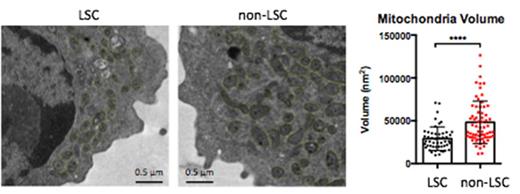Abstract
Studies from normal cell biology have demonstrated that mitochondria can switch between fission-active and fusion-active states to dramatically change their morphology during important developmental events such as lineage differentiation and cell division. Further, very recent research has revealed intriguing interactions between mitochondrial morphology regulation and oncogenic signals in cancer. To date however, whether mitochondrial morphology regulation plays a role in cancer stem cell function remains largely unknown.
We report, in acute myelogenous leukemia (AML), leukemia stem cells (LSCs), characterized by a low level of reactive oxygen species (ROS), have hyper-active mitochondrial fission regulators as evidenced by higher levels of mitochondrial fission 1 (FIS1) and activating phosphorylation of dynamin-related protein 1 (DRP1), compared to non-LSCs. To directly compare the mitochondrial morphology in LSCs versus non-LSCs, we imaged mitochondrial morphology using transmission electron microscopy. Quantification of the imaging results showed that the LSCs contain an increased number of smaller and globular-shaped mitochondria (see Figure), indicating that they reside in a fission-active state relative to non-LSCs. Inhibition of mitochondrial fission through genetic knock-down of FIS1 (FIS1-KD) induces mitochondrial fusion and dramatically diminishes both colony-forming ability and serial engraftment potential of primary AML cells, suggesting a fission-active state of mitochondrial morphology is critical for LSC function.
To dissect the mechanism by which FIS1 regulates primitive leukemia cells, we performed detailed analysis of molecular events following FIS1-KD. We found that AML cells lacking the function of FIS1 up-regulated the expression of mitochondrial oxidative phosphorylation (OXPHOS) proteins, suggesting an increased OXPHOS activity. We then observed through metabolomic studies that knock-down of FIS1 altered the level of metabolites involved in glycolysis and the citric acid cycle (TCA), suggesting that the FIS1-KD-induced change in OXPHOS activity affected other aspects of global cellular energy metabolism as well. Among the metabolic changes seen was an increase in Acetyl-CoA, which plays an important role in epigenetic regulation by serving as the substrate for histone acetylation. Consistently, we observed an increase in H3K27-acetylation in AML cells following FIS-KD, and our transcriptomic analysis using RNA-seq showed that AML cells lacking FIS1 function exhibited global up-regulation of a hematopoietic lineage differentiation gene signature including CD11B, CD14, CD36, and CD68, indicating an induction of differentiation. In addition to affecting energy metabolism and epigenetic landscape, FIS1-KD also increased cellular ROS level in AML cells. This may happen as a consequence of induced OXPHOS activity, since ROS is a major byproduct of oxygen metabolism in OXPHOS machineries.
Taken together, our functional studies raise the hypothesis that mitochondrial morphology critically regulates LSC function. Our subsequent molecular studies begin to reveal two major potential mechanisms by which mitochondrial morphology regulators can affect LSC potential. First, FIS1-regulated mitochondrial morphology may sequentially affect mitochondrial OXPHOS activity, global energy metabolism, homeostasis of metabolites such as Acetyl-CoA that can link metabolism to epigenetics, and regulation of the epigenome that is required for sustaining LSCs. Second, FIS1 can also affect cellular ROS, a critical determinant of self-renewal ability of stem cells, to effect LSC function. Overall, our current study elucidates a previously unknown link between the regulation of mitochondrial morphology and LSC function, targeting of which represents a novel therapeutic means to eradicate LSCs.
Pollyea:Ariad: Consultancy; GlycoMimetics: Other: Member of data safety monitoring board; Agios: Consultancy, Membership on an entity's Board of Directors or advisory committees; Celgene: Consultancy, Membership on an entity's Board of Directors or advisory committees, Research Funding; Pfizer: Consultancy; Karyopharm: Consultancy.
Author notes
Asterisk with author names denotes non-ASH members.


